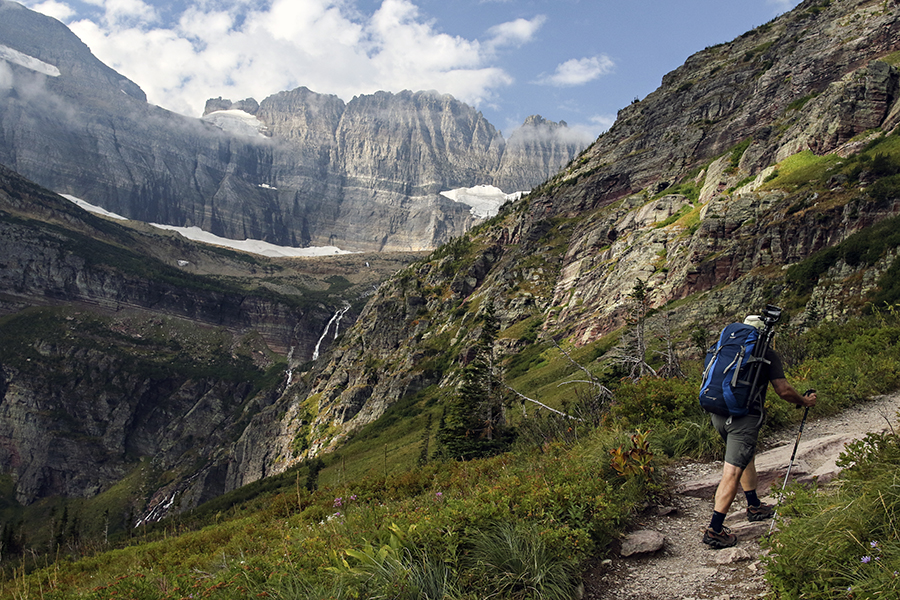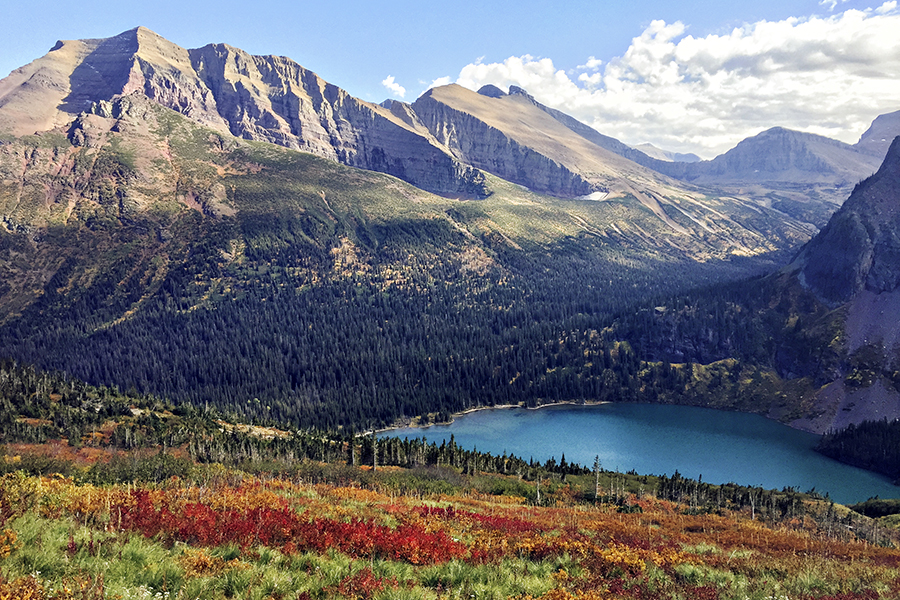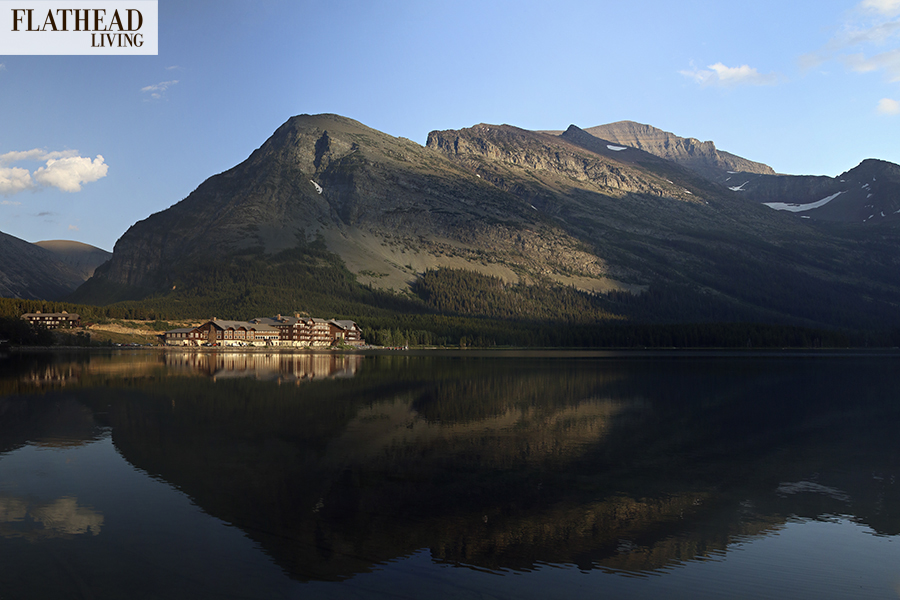The road to Many Glacier is paved with … well, it’s paved.
It’s also wet, and dirty, and erratically sloped, and filled with car-swallowing potholes, and overrun with obstinate cows, but the rewards at the end of the road are worth the difficult journey. In fact, one could argue that the experience of white-knuckling while driving 10 to 15 miles per hour — lest you leave with one less hubcap than you drove in with or collide with one of those wayward cows — makes arriving at the Many Glacier Hotel even more satisfying, like a climber bagging a particularly rugged peak.
Perhaps it’s something that Diane Sine, a more than 30-year veteran of Glacier National Park and the lead interpretive ranger in the Many Glacier area, has heard from the multitudes of guests who visit the region each year.
“It does give it that more remote feel,” Sine says, reluctantly, before more candidly adding: “I do not hear from a lot of people who consider it an asset to their Many Glacier experience.”
So maybe the road to Many Glacier — a stretch of about 12 miles of National Park Service road alongside Lake Sherburne — is more frustrating impediment than selling point, but it hasn’t deterred locals and tourists alike from enjoying the splendor of the area.
And Many Glacier is just one of the treasures of Glacier National Park that exist outside of the iconic Going-to-the-Sun Road and its highpoint, Logan Pass, that make taking an extra hour or so in the car a worthwhile endeavor. From Many Glacier’s mountainous splendor to the wide-open spaces of St. Mary to the sanctified Chief Mountain, the park’s east side is something special to explore.

Before we go any further, let’s get a few things out of the way about that road.
Yes, it’s owned by the Park Service. Yes, they know it’s terrible. No, they can’t stop those cows from coming over. And yes, they are trying to do something about it.
“The situation with the road is very challenging,” Sine said. “The reality is (it’s) built on a kind of road that is not very stable, and then you add the Sherburne Reservoir, which is an artificial reservoir that is raised and lowered throughout the year, and that makes the soil underneath the road even less stable.”
It’s also not a new problem. Sine said historical reports note that within 15 years of the road being built it was already falling apart. For years, she added, engineers have been studying ways to stabilize the surface, and Sine very cautiously predicted something could be done by 2020 at the earliest.
As for those cows, they meander onto the road from private land adjacent to the park boundary and have so far outfoxed park officials who try to keep them out.
“The cows are pretty good at breaking through those fences and going where they want to go,” Sine said.
Of course, cows aren’t the only animals that can be seen on or near the road to Many Glacier. That area, and in fact much of the park’s east side, is known to be one of the best spots for wildlife viewing because of the more open expanses available there.
“Some of the most amazing hikes in the park are on the east side,” Sine said. “We’re known for dramatic vistas on the trails … We don’t have the dense, dark forest of the west side.”
Hikes like Cracker Lake, Grinnell Glacier and Iceberg Lake are remarkable, but the well-known trails are extremely well traveled, and the Many Glacier area, despite the relative inconvenience of traveling there, has seen growth in visitation in line with the rest of Glacier Park, which has set annual attendance records for three straight years.
Sine described the hike to Iceberg Lake as “pretty much a solid stream of hikers,” and last year the Park Service temporarily blocked vehicle access to Many Glacier more than a dozen times, when the parking area filled and the dead-end road gridlocked.
Aside from the hikes, the end of the road itself presents one of the main attractions, the historic Many Glacier Hotel, one of the first chalets constructed by the Great Northern Railway shortly after the park was opened in 1910.
“Right from the outset, Many Glacier Hotel was just about the most popular destination in the park,” historian and author Ray Djuff said.
The Swiss-inspired hotel is the largest inside Glacier National Park, and its location on the shores of Swiftcurrent Lake makes it home to unmatchable views. The hotel’s construction, however, was part of a much larger project, not without some controversy, that first brought people other than Native Americans onto the park’s eastern lands.

In the late 19th century, according to Djuff, miners started trespassing onto Blackfeet tribal territory looking to capitalize on the copper and gold rushes of that era, although neither of those treasures would ever be discovered in what is now the park. In response to the increased activity, the U.S. purchased the land that would eventually become Glacier National Park for $1.5 million in 1895, and in the initial agreement, the Blackfeet were to have retained the rights to “hunt, fish and cut timber” on land they consider sacred.
“At the time, the people sold it out of necessity,” Darrell Norman, an artist, gallery owner in Browning and member of the Blackfeet Nation, said. “The buffalo were gone, people were starving; they needed the money. And our decision, in order to save our people, was to sell what is now Glacier National Park.”
The Blackfeet had relied on the land on the east side of modern-day Glacier Park for sustenance, hunting, fishing and picking berries, but the land also carried — and continues to carry — significant spiritual significance for the Blackfeet.
“Creation began in these areas,” Norman explained. “I’m sitting here in my studio looking into the mountains every single day and there’s something very powerful about the mountains — the whole area to me is very powerful.”
Norman explained the Blackfeet word for mountains, mistakists, means “something pushing up from the earth,” a definition he says demonstrates just how long the Blackfeet have been living along the Rocky Mountain Front. Because of that history, generations of Blackfeet have taken vision quests in the areas near Many Glacier, East Glacier and Badger-Two Medicine, while Chief Mountain — less than 10 miles from the Canadian border and along Glacier Park’s eastern edge — is a particularly hallowed place.
“We have no churches, so those outdoor places are our churches, our cathedral,” Norman said. “It has everything to do with us as a people and our history and our spiritual beliefs, too.”
Norman added that some traditional Blackfeet ceremonies, including the Beaver Bundle and the Thunder Pipe Bundle, have origins in the area that is now East Glacier.
The Blackfeet, according to Norman, were supposed to continue to have unfettered access to those sacred areas to hunt, gather and perform ceremonies, but when Glacier National Park was created in 1910, the rules governing national park land restricted Blackfeet access the same way it did any other visitor.
“When it became a national park, they got amnesia and they forgot what they had agreed to,” Norman said. “It’s been a point of contention ever since that time.”
There are still vestiges of Blackfeet history on the east side of the park, and reservation lands begin just outside the eastern boundaries — including towns like Browning and Babb — where visitors can still learn about and appreciate the region’s centuries-old history.
Norman owns and operates the Lodgepole Gallery and a Tipi Village where guests can rent tipis and dine on Blackfeet cuisine. The Museum of the Plains Indian in Browning is another great way to encounter Blackfeet history, and Norman and others are working on ways to capture more of the dollars tourists spend when they visit the nearby national park.
“If we’re going to respond to tourism, we have to find a way to draw them into our community here,” Norman said. “It’s got to start somewhere and sometime. Is it going to be individuals or is it going to be the tribal government itself? I think it’s going to be a combination.”

Back inside the park, and back to the 1910s when Glacier was first created, it was a different group that was looking to capitalize economically on the natural landscape.
Louis Hill, son of Great Northern Railway founder James J. Hill, saw the success that surrounding areas were having in promoting the park as a destination for tourists via the burgeoning railway and identified a new frontier.
“The Great Northern developed the east side of the park, essentially,” Djuff said. “Louis Hill saw the beauty of the region, the fact it was underdeveloped; he would have no challengers and the railway could hold a monopoly.”
Hill’s chalets, many of which still stand today, popped up at Many Glacier, East Glacier Park (then called Midvale), Two Medicine and St. Mary, along with others on the west side. A powerful advertising push helped the chalets gain instant popularity, even if they weren’t particularly well run and their remote locations presented large logistical challenges.
“The setup was rough at times, but it operated,” Djuff said. “Customers were still pleased and what thrilled them was the scenery. They got to see areas that were new to the American public and absolutely beautiful, so if you were able to fill their belly in the morning, get them a horse and give them somewhere comfortable to sleep, that was enough.”
That mantra, in some ways, is enough to keep visitors to Glacier’s east side happy today.
Towns like East Glacier Park, where drivers following U.S. Highway 2 end up once they cross through the park, manage to capitalize on the tourism boom despite having few attention-grabbing amenities.
“Our claim to fame would be that we’re near the Two Medicine entrance to Glacier National Park,” Maria Folsom of the East Glacier Chamber of Commerce said. “It’s different. It’s much more remote than going through Going-to-the-Sun Road; East Glacier kind of exists because of that.”
Folsom was quick to add that the town does have modern conveniences for visitors, including popular and well-regarded restaurants and businesses offering rafting trips, horseback riding, bicycle rentals and bus tours. But the real draw remains the outdoor splendor, including spectacular hikes like Scenic Point and the Dawson-Pitamakan loop.
Even here, though, visitors aren’t immune to travel backups. The Two Medicine area, like Many Glacier, is accessible only by a dead-end road.
“The biggest piece of advice for visitors,” Sine said, “is they just really need to be flexible. We’re doing the best we can with a situation that presents itself more every year and we’re trying the best we can.”
That said, there are hidden treasures that remain buried deep inside Glacier National Park, particularly on the east side, if you’re willing to venture off the more well-known trails. The only problem is getting anyone to tell you precisely where those trails are — a question nearly as bristling as asking to reveal a favorite fishing hole.
“It’s conflicting, I think, for all of us,” Sine said. “It is harder to find the solitude and peace and quiet, but at the same time we recognize that the people who are coming here are looking for this experience and we want to share this place and we want the public to experience the national parks.”
It was as a college student that Sine first discovered Many Glacier while working at the hotel, and she’s fallen head over heels in love with the place since that time, even getting married at Lake Josephine a few years back. She’s seen the park change in ways few others have, slowly watching Grinnell Glacier succumb to a changing climate and the parking lots fill in ways they never have before. But she’s not ready to leave anytime soon, either, and she does have one piece of advice she’s more than willing to share.
“Having lived in the Flathead Valley for decades, it seems like a lot of people stop at Logan Pass,” she said. “I would just really encourage people to get over here … It’s a whole different world.”
Read more of our best long-form journalism in Flathead Living. Pick up the summer edition for free on newsstands across the valley.
